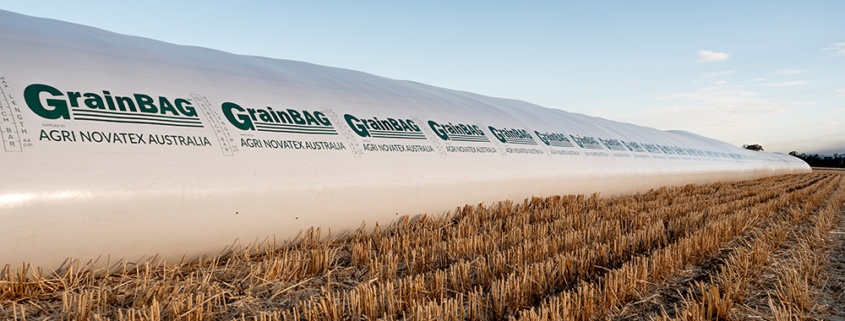Manging price and weather risk with on-farm storage
Flexible on-farm grain storage solutions are hot property this harvest as growers look for ways to manage uncertain commodity prices and weather.
Headers haven’t even hit the paddocks, but growers have been rushing to secure grain bags to bolster on-farm storage options to control some of their harvest price risk.
Agri Novatex Australia Western Zone Customer Relationship Manager, Neil McAlpine, said there was a large grain bag supplier in the eastern states that indicated there could be difficulties supplying additional demand. “There’s been a lot of early demand on grain bags,” he said. “I would suggest there is a potential for a shortage – the result of high demand and COVID-19 potentially delaying imports. At this stage, Agri Novatex will have their GrainBAG™ available in Western Australia before the commencement of harvest.”
Agri Novatex Australia is a new business which now sells the trusted grain and fodder brands such as GrainBAG™, SilaWRAP™, SilaNET™, SilaTWINE™ and PitCOVER™. Totally dedicated to farming, Agri Novatex combines global innovation and heritage with Australian on-farm experience and knowledge.
Agri Novatex sells the brand GrainBAG™ to distributors which enables it to focus on one customer-base, meeting specific needs quickly and easily.
Mr McAlpine has worked with grain bag technology since its introduction to Australia about 20 years ago. He said the increasing popularity of grain bags in Australia was not surprising, considering the cost savings, storage flexibility and marketing control it provides. “It’s a cost-efficient grain storage option,” he said. “It can be half to two-thirds less than the cost of traditional storage options and allows growers to manage challenges such as weather, commodity prices, labour and transport. “There is a possibility that drivers could be delayed at bulk storage bins. If your transportation relies on contractors, the cost of harvest could be a lot more. You can also bring your storage right into the field you are harvesting – straight from the harvester into the chaser bin, and from the chaser bin into the grain bag via an in-loading machine.”
Grain Bags are mostly used for cereal crop, but other crops – such as pulses- can also be stored. Pulses are generally only stored for short periods of time. Agri Novatex GrainBAG™s come in different sizes with storage options from 220 to 488 tonne (based on wheat).
Organic cereal growers are an emerging and growing market for grain bags as they provide the flexibility to segregate varieties, according to Mr McAlpine. Unlike traditional silo storage – where grain requires chemical protection against insects – grain stored in a grain bag under the right conditions, may not require additives for protection. “If you fill them with grain at the right moisture levels, around 12.5 per cent, the grain provides a hermetic environment,” Mr McAlpine said. “The grain uses all the oxygen in the bag and as a result, there’s a higher concentration of carbon dioxide. This doesn’t necessarily kill the bugs and fungi, but it keeps them moribund – it stops them from being active.”
Getting the most out of a grain bag comes down to planning, storage, and maintenance, according to Mr McAlpine. “The big thing, and it is the critical thing, is where you place the grain bag,” he said. “Successful use of grain bags as an on-farm grain storage option requires a carefully- prepared pad. Anecdotally, an elevated, well-drained pad provides optimal results where no stubble (which can harbor vermin) or rocks can tear the grain bags as they are being filled and unloaded.” Other suggestions include fencing the area and patching any holes as soon as possible with Agri Novatex SilaTAPE™.
Loading and unloading a grain bag requires specific machinery. Mr McAlpine said most growers generally prefer to own their in-loader, and possibly share an out-loader with fellow farmers. These machines are also avaliable to hire.
Mr McAlpine said in WA there were some growers with leftover grain bags from last year, but he expects more will be needed as harvest approaches. “Fundamentally, demand depends entirely on the size of the harvest,” he said. “While we are still a fair way off, the season in WA has improved considerably in the last month or so thanks to pretty reasonable rains.”




